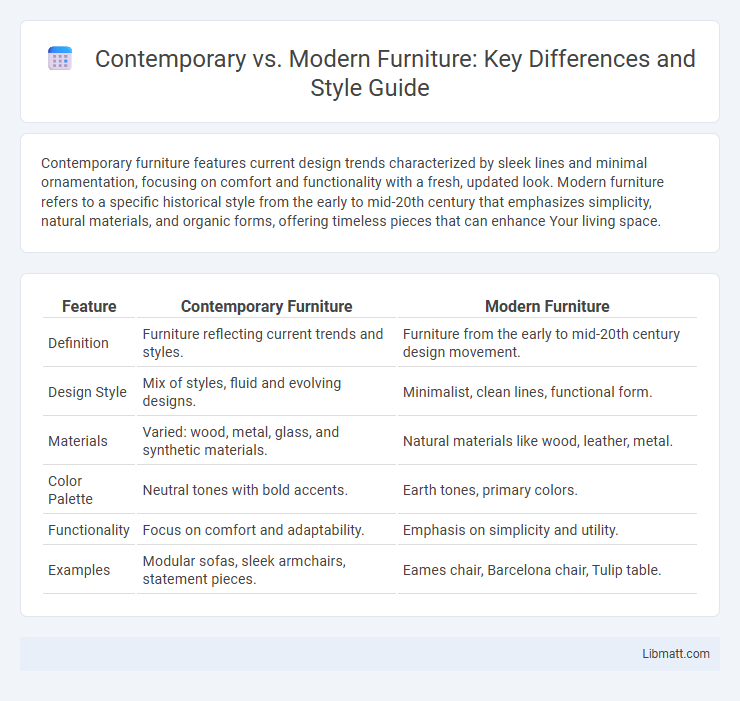Contemporary furniture features current design trends characterized by sleek lines and minimal ornamentation, focusing on comfort and functionality with a fresh, updated look. Modern furniture refers to a specific historical style from the early to mid-20th century that emphasizes simplicity, natural materials, and organic forms, offering timeless pieces that can enhance Your living space.
Table of Comparison
| Feature | Contemporary Furniture | Modern Furniture |
|---|---|---|
| Definition | Furniture reflecting current trends and styles. | Furniture from the early to mid-20th century design movement. |
| Design Style | Mix of styles, fluid and evolving designs. | Minimalist, clean lines, functional form. |
| Materials | Varied: wood, metal, glass, and synthetic materials. | Natural materials like wood, leather, metal. |
| Color Palette | Neutral tones with bold accents. | Earth tones, primary colors. |
| Functionality | Focus on comfort and adaptability. | Emphasis on simplicity and utility. |
| Examples | Modular sofas, sleek armchairs, statement pieces. | Eames chair, Barcelona chair, Tulip table. |
Defining Contemporary and Modern Furniture
Contemporary furniture refers to designs that are current and ever-evolving, often integrating the latest materials and trends, while modern furniture specifically denotes styles from the early to mid-20th century, particularly those influenced by the Modernist movement. Modern furniture emphasizes clean lines, minimal ornamentation, and functional forms rooted in industrial design principles, whereas contemporary furniture embraces a broader range of styles and often incorporates innovative, eclectic elements. Understanding the distinction helps consumers choose between the timeless simplicity of modern classics and the dynamic, trend-responsive nature of contemporary pieces.
Historical Origins and Evolution
Modern furniture originated in the early 20th century, largely influenced by the Bauhaus movement and designers like Le Corbusier and Ludwig Mies van der Rohe, emphasizing simplicity, functionality, and the use of industrial materials. Contemporary furniture, however, reflects current design trends and incorporates a blend of styles, often prioritizing comfort and innovation with sustainable materials and cutting-edge technology. Understanding these historical origins helps you appreciate how modern furniture's minimalist roots have evolved into the diverse, ever-changing designs of contemporary pieces.
Key Design Characteristics
Contemporary furniture features clean lines, minimal ornamentation, and a focus on simplicity, often incorporating mixed materials like metal, glass, and natural fibers. Modern furniture emphasizes functionality with sleek, geometric shapes and uses materials such as wood, leather, and steel, reflecting the design trends from the early to mid-20th century. Your choice between the two depends on whether you prefer the ever-evolving style of contemporary design or the timeless, functional appeal of modern aesthetics.
Popular Materials Used
Popular materials in contemporary furniture include metal, glass, and engineered wood, reflecting a sleek and minimalist aesthetic. Modern furniture frequently features natural wood, leather, and molded plywood, emphasizing organic shapes and functional design. Both styles prioritize high-quality materials that enhance durability and visual appeal.
Color Palettes and Finishes
Contemporary furniture features a dynamic color palette, often embracing bold hues, metallics, and high-gloss finishes that reflect current design trends. Modern furniture typically sticks to muted, neutral tones such as whites, blacks, and earth tones with matte or natural wood finishes that emphasize simplicity and function. Your choice between the two should consider how color palettes and finishes align with the desired atmosphere and complement existing decor.
Functionality and Versatility
Contemporary furniture emphasizes functionality with clean lines and adaptable designs that complement evolving living spaces, while modern furniture focuses on simplicity and minimalism with fixed forms and materials. Your choice between contemporary and modern pieces can enhance versatility in your home by accommodating various uses and styles. Prioritizing multifunctional elements in contemporary furniture supports dynamic lifestyles, whereas modern furniture provides timeless functionality through streamlined, purpose-driven design.
Influential Designers and Brands
Influential designers like Charles and Ray Eames shaped modern furniture with their emphasis on functional simplicity and organic forms, while contemporary furniture draws inspiration from designers such as Patricia Urquiola and brands like Roche Bobois, known for innovative materials and eclectic styles. Modern furniture is characterized by iconic mid-20th century creators including Le Corbusier and Ludwig Mies van der Rohe, whose works remain staples in minimalist design. Contemporary furniture constantly evolves with trends, incorporating sustainable practices and technology-driven aesthetics from brands like Herman Miller and Knoll.
How to Distinguish Contemporary from Modern
Contemporary furniture reflects current design trends emphasizing minimalism, organic shapes, and a mix of materials like metal, wood, and glass, while modern furniture refers specifically to designs from the early to mid-20th century inspired by movements such as Bauhaus and Mid-Century Modern. Unlike modern furniture's clean lines and functional forms rooted in historical movements, contemporary pieces evolve with the latest innovations and often incorporate sustainable materials. Recognizing the distinction involves noting whether the style represents a specific historic design era (modern) or the ever-changing present-day aesthetic (contemporary).
Integrating Styles in Home Décor
Contemporary furniture emphasizes clean lines and current trends, seamlessly blending with diverse design elements to create a versatile home decor. Modern furniture, rooted in the mid-20th century, features minimalist shapes and functional forms that complement both vintage and contemporary interiors. Integrating contemporary and modern styles enhances spatial harmony, adding depth and character through balanced contrasts in materials and finishes.
Choosing the Right Furniture for Your Space
Contemporary furniture features current design trends with smooth lines and minimal ornamentation, while modern furniture refers to styles from the early to mid-20th century emphasizing function and simplicity with natural materials. Choosing the right furniture involves assessing your space's size, light, and existing decor to ensure harmony between aesthetic and practicality. Opt for contemporary pieces to create a fresh atmosphere or modern designs to evoke timeless elegance and historical significance.
contemporary vs modern furniture Infographic

 libmatt.com
libmatt.com